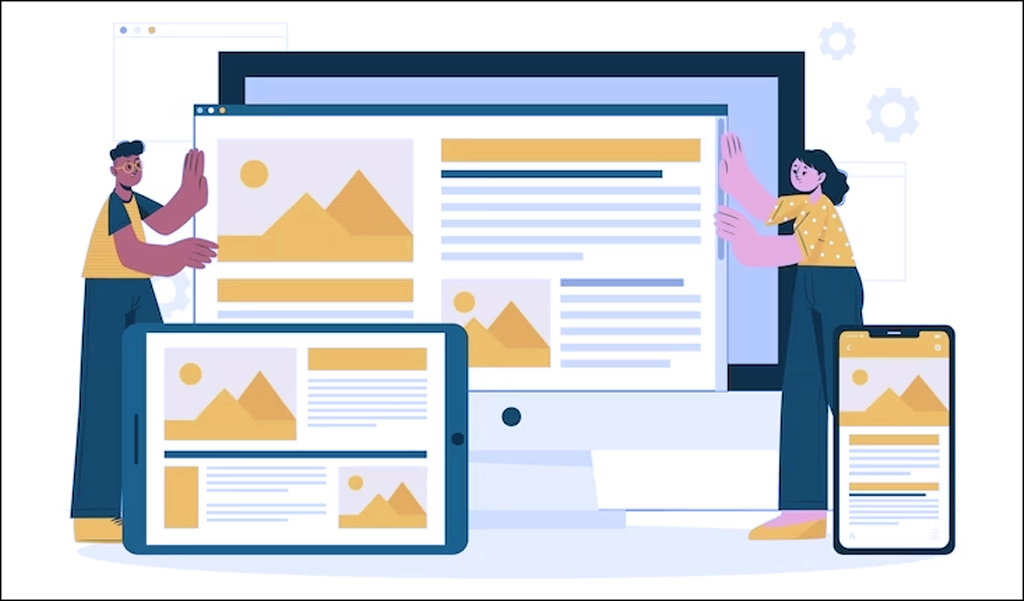Why Responsive Design Matters: Unlocking the Secrets to a User-Friendly Website Experience!
Table of contents

In this blog post by responsive web design company, you will learn why responsive design is an important factor in creating a user-friendly website experience. Responsive design ensures that websites are optimized for a variety of devices, providing the best user experience possible. By understanding the importance of responsive design and its advantages, you can create a web experience that is both enjoyable and accessible to users.
Introduction: What is Responsive Design?
As more and more people access the internet through their mobile devices, it is becoming increasingly important for websites to be optimized for different screen sizes. This is where responsive design comes in. Responsive design is a web design approach that ensures a website can adapt to different screen sizes and devices, providing users with an optimal viewing experience. With a responsive design, a website can adjust its layout, font size, and image sizes to fit the screen of the device being used to access it. This means that users can easily navigate and interact with the website, regardless of the device they are using. Responsive design is not just a trend, it is a necessity in today’s digital landscape. By implementing responsive design, businesses can ensure that their website is accessible to a wider audience, providing a better user experience and ultimately increasing engagement and conversions. So, if you want to stay ahead of the curve and provide your users with a seamless website experience, implementing responsive design is a must.
Benefits of Responsive Design
Responsive design is a crucial aspect of web design that cannot be ignored. It is a design approach that enables websites to adapt to different screen sizes and devices, providing a seamless user experience across all platforms. The benefits of responsive design are numerous, and they all contribute to making your website more user-friendly. Firstly, responsive design ensures that your website is accessible to all users, regardless of the device they are using. This means that your website will be able to reach a wider audience, increasing your chances of attracting more traffic and potential customers. Secondly, responsive design enhances the user experience by providing a consistent and intuitive interface that is easy to navigate says Web Design Jacksonville. Users can easily find what they are looking for, and they can do so without having to zoom in or out or scroll horizontally. Finally, responsive design can improve your website’s search engine rankings, as search engines prefer websites that are mobile-friendly. By implementing responsive design, you can ensure that your website is optimized for search engines, making it easier for users to find your website. In conclusion, responsive design is a must-have for any website that wants to provide a user-friendly experience and stay ahead of the competition.
Common Challenges of Creating a Responsive Website

When it comes to creating a responsive website, there are several challenges that web designers and developers face. One of the most common challenges is ensuring that the website is compatible with various devices and screen sizes. With the increasing use of mobile devices, it is crucial to ensure that the website is optimized for smaller screens while maintaining its functionality and design. Another challenge is maintaining the website’s speed and performance. A responsive website should load quickly and smoothly on all devices, which requires careful optimization of images, videos, and other media. Additionally, creating a responsive website requires a significant amount of testing and debugging to ensure that it works seamlessly across all devices and platforms. Despite these challenges, creating a responsive website is essential for providing a user-friendly experience to visitors. With a responsive website, users can easily access information and navigate the site, regardless of the device they are using. By overcoming these challenges, web designers and developers can create a website that is not only responsive but also engaging and user-friendly.
How to Optimize Your Website for Responsive Design
If you want your website to be user-friendly and accessible to all kinds of devices, then you need to optimize it for responsive design. Responsive design is a web design approach that allows your website to adapt to different screen sizes and resolutions. By optimizing your website for responsive design, you can ensure that your website looks great on any device, whether it’s a desktop, laptop, tablet, or smartphone. To optimize your website for responsive design, you need to start by creating a flexible layout that can adjust to different screen sizes. You also need to use scalable images and fonts that can resize without losing their quality. Additionally, you should use CSS media queries to adjust the layout and content of your website based on the device’s screen size. By optimizing your website for responsive design, you can provide a seamless user experience across all devices and increase your website’s visibility and engagement. So, if you want to unlock the secrets to a user-friendly website experience, then you need to prioritize responsive design.
Tips for Creating a User-Friendly Experience with Responsive Design

Responsive design is a crucial aspect of creating a user-friendly website experience. In today’s world, where people use various devices to access websites, it is essential to ensure that your website is responsive to different screen sizes. Here are some tips for creating a user-friendly experience with responsive design. Firstly, keep it simple. A cluttered website can be overwhelming and confusing for users. Secondly, make sure your website is easy to navigate. Users should be able to find what they are looking for quickly and easily. Thirdly, use high-quality images and videos that load quickly. Slow loading times can frustrate users and lead to a high bounce rate. Fourthly, ensure that your website is accessible to everyone, including those with disabilities. Finally, test your website on different devices and browsers to ensure that it is responsive and works well on all platforms. By following these tips, you can create a user-friendly website experience that will keep visitors coming back for more.
Challenges with Implement responsive design
While responsive design has become a necessity for any website looking to provide a user-friendly experience, it is not without its challenges. One of the biggest challenges is ensuring that the design is consistent across all devices. With so many different screen sizes and resolutions, it can be difficult to create a design that looks good on all of them. Additionally, implementing responsive design can be time-consuming and require significant resources. It may require a complete overhaul of the website’s code and design, which can be a daunting task. However, the benefits of responsive design far outweigh the challenges. A responsive design ensures that your website is accessible to all users, regardless of the device they are using. It also helps to improve your website’s search engine rankings and can lead to increased traffic and conversions. While it may require some extra effort, implementing responsive design is a crucial step in creating a successful and user-friendly website.
Conclusion: Why Responsive Design Matters

In conclusion, responsive design is a crucial aspect of creating a user-friendly website experience. With the rise of mobile devices, it’s more important than ever to ensure that your website is optimized for all screen sizes. A responsive design allows your website to adapt to any device, providing a seamless experience for your users. Not only does this improve user experience, but it also has a positive impact on your website’s search engine rankings. Google has made it clear that mobile-friendly websites are a priority, and a responsive design is the best way to achieve this. According to responsive web design agency, a responsive design can save you time and money in the long run by eliminating the need for separate mobile and desktop versions of your website. By prioritizing responsive design, you’re not only improving your website’s functionality, but you’re also future-proofing it for any new devices that may come out in the future. Ultimately, investing in a responsive design is an investment in the success of your website and your business.







